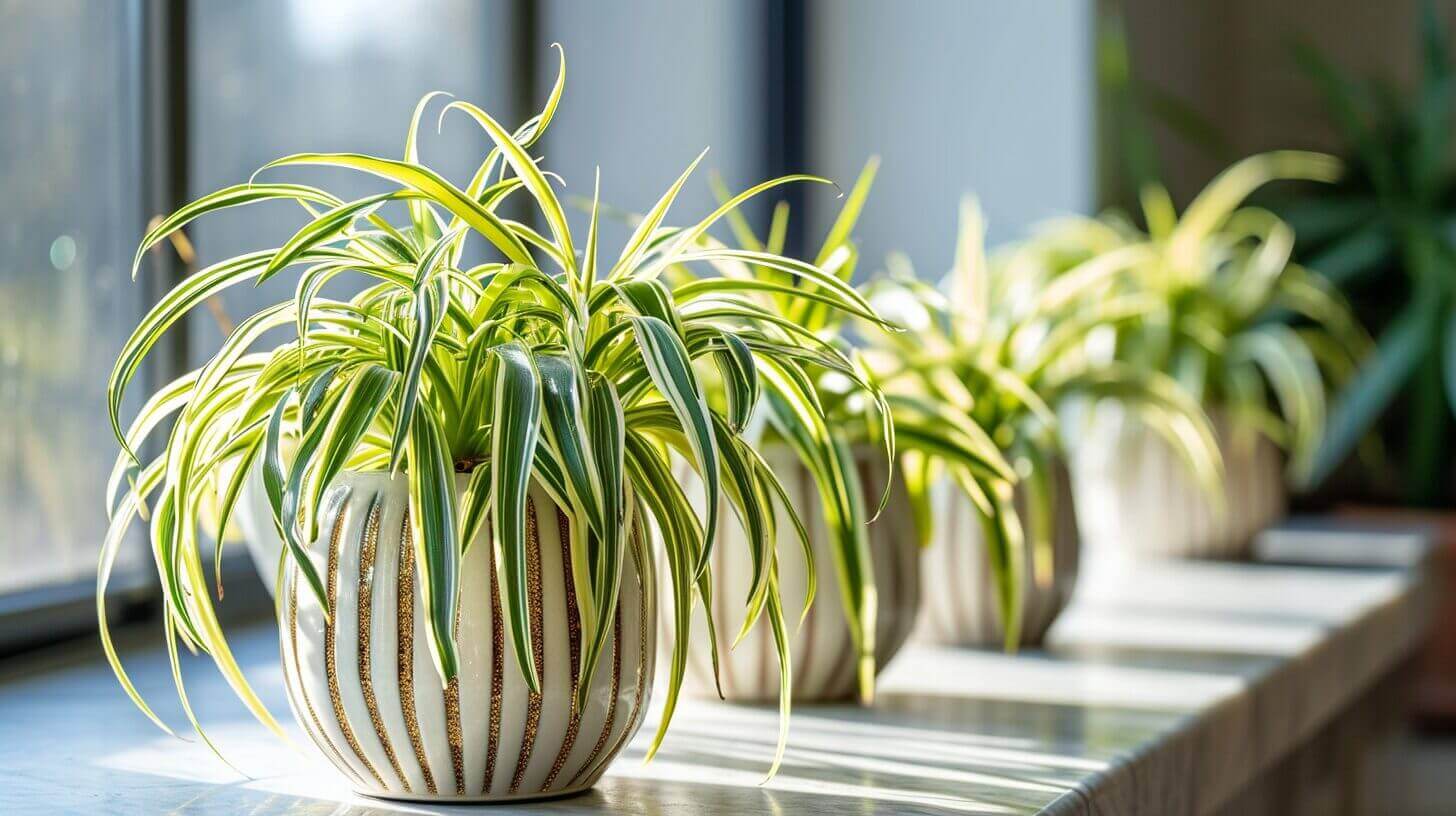Are you wondering where to place your spider plant for optimal growth and health? Look no further.
In this article, we will provide you with ideal placement tips to help you create the perfect environment for your spider plant. By considering factors such as natural light, temperature, humidity, and avoiding drafts, you’ll be able to find the ideal location in different rooms of your home.
Let’s explore the best ways to serve your spider plant’s needs and enhance the beauty of your living space.
Key Takeaways
- Spider plants thrive in bright, indirect light and can tolerate some direct sunlight.
- They prefer moderate temperatures between 60°F and 75°F and a humidity level of 40% to 60%.
- It is important to avoid placing spider plants in complete darkness and to provide proper drainage and room for root growth.
- Spider plants should be placed away from drafts, air conditioning vents, and direct sunlight to prevent leaf damage and stress.
Natural Light Requirements for Spider Plants
One of the key factors in successfully caring for spider plants is providing the appropriate amount of natural light. Whether you are growing your spider plant indoors or outdoors, understanding its light requirements is essential.
Spider plants thrive in bright, indirect light, making them ideal for indoor spaces. However, they can also tolerate some direct sunlight, especially in the morning or late afternoon. When it comes to indoor spider plant care, placing them near a window with filtered light is ideal.
If you have low light conditions in your home, don’t worry! Spider plants are known to be adaptable and can tolerate lower light levels. Just make sure to avoid placing them in complete darkness.
Temperature and Humidity Considerations for Spider Plant Placement
Temperature and humidity are both important factors to consider when determining the best placement for a spider plant, as they can greatly impact its growth and overall health. Spider plants thrive in moderate temperatures between 60°F and 75°F (15°C and 24°C). Extreme temperatures, whether hot or cold, can be detrimental to their well-being. It is crucial to provide adequate temperature and humidity control to ensure the plant’s optimal development.
When it comes to humidity, spider plants prefer a moderate level of humidity, ranging from 40% to 60%. If the air is too dry, the plant may experience leaf browning and curling. On the other hand, excessive humidity can lead to fungal issues and root rot. Maintaining appropriate humidity levels through natural or artificial means, such as misting the leaves or using a humidifier, is essential for spider plant care in extreme conditions.
To summarize the temperature and humidity requirements for spider plant care, refer to the table below:
| Temperature | Humidity | Spider Plant Care |
|---|---|---|
| 60°F – 75°F | 40% – 60% | Moderate |
Choosing the Right Indoor Space for Your Spider Plant
The location of your spider plant within your indoor space is a crucial factor in ensuring its optimal growth and health. Spider plants thrive in bright, indirect light, so it’s important to choose a spot that receives plenty of natural light throughout the day. Avoid placing your spider plant in direct sunlight, as this can scorch its leaves.
Additionally, spider plants prefer temperatures between 60 and 75 degrees Fahrenheit, so choose a location that maintains a consistent temperature within this range. When it comes to pot size, select a container that allows for proper drainage and provides enough room for the plant’s root system to grow.
Spider plants are forgiving when it comes to watering frequency, but it’s best to keep the soil lightly moist. Avoid overwatering, as this can lead to root rot. With these considerations in mind, your spider plant will thrive in its chosen indoor space.
Now, let’s discuss the importance of avoiding drafts and air conditioning for spider plant health.
Avoiding Drafts and Air Conditioning for Spider Plant Health
To ensure optimal health for your spider plant, it is important to avoid drafts and refrain from placing it near air conditioning vents. Drafts can cause stress to the spider plant, as they can lead to temperature fluctuations and dry out the leaves. Similarly, air conditioning vents can expose the plant to cold air and dry conditions, which can negatively impact its overall health.
In addition to avoiding drafts and air conditioning, it is also crucial to place your spider plant away from direct sunlight. While spider plants thrive in bright, indirect light, direct sunlight can scorch the leaves and hinder their growth.
By providing your spider plant with a well-ventilated area away from drafts, air conditioning, and direct sunlight, you will create the ideal conditions for it to flourish.
Now, let’s explore the ideal location for your spider plant in different rooms of your home.
Finding the Ideal Location for Your Spider Plant in Different Rooms of Your Home
When determining the ideal location for your spider plant in different rooms of your home, consider both the lighting conditions and the available space.
Spider plants thrive in bright, indirect light, so placing them near a window or in a well-lit room is ideal. However, direct sunlight can scorch their leaves, so it’s important to find a balance.
In terms of space, spider plants are adaptable and can fit into small corners or hang from baskets. Just ensure that they have enough room to grow and spread their long, arching leaves.
Additionally, it’s important to note that spider plants have moderate watering requirements. They prefer to be slightly dry between waterings, so allow the top inch of soil to dry out before watering again.
As for fertilizers, spider plants benefit from a balanced, water-soluble fertilizer applied every other month during the growing season.
Frequently Asked Questions
Can Spider Plants Survive in Low Light Conditions?
Spider plants can indeed survive in low light conditions, making them a great choice for indoor spaces with limited natural sunlight. These plants have a high tolerance for low light and can thrive in areas with indirect or artificial lighting.
However, it is important to note that spider plants may not grow as vigorously in low light settings compared to brighter environments. To ensure their wellbeing, it is recommended to place spider plants near a window with filtered light or use artificial grow lights to supplement their lighting needs.
How Often Should Spider Plants Be Watered?
Spider plants should be watered regularly to maintain their health. The frequency of watering depends on various factors, such as the temperature, humidity, and the size of the plant.
Generally, spider plants should be watered when the top inch of soil feels dry to the touch. Overwatering can lead to root rot, while underwatering can cause the leaves to wilt. It is important to strike a balance and provide adequate moisture to ensure the plant thrives.
Can Spider Plants Be Placed Outdoors?
Spider plants can indeed be placed outdoors, as long as certain care guidelines are followed.
Outdoor spider plant care involves finding a location that provides indirect sunlight, as direct sunlight can scorch the leaves. It is also important to protect the plant from extreme temperatures and strong winds.
Regular watering and occasional fertilization are necessary to maintain the plant’s health.
What Is the Best Placement for Propagated Spider Plants?
Overwatering spider plants can lead to several signs that indicate excessive moisture. These include:
- Yellowing or browning of the leaves
- Wilting
- Root rot
- A foul odor
To prevent overwatering, it is essential to ensure that the plant is placed in a well-draining pot with good ventilation. Additionally, allowing the soil to dry out between waterings and avoiding standing water in the pot can help maintain optimal moisture levels for spider plants.
Can Spider Plants Be Placed Near Radiators or Heating Sources?
Spider plants thrive in moderate temperatures and prefer indirect sunlight. However, when considering the placement near radiators or heating sources for spider plants, caution is advised.
The excessive heat generated by radiators or heating sources can cause the soil to dry out quickly, leading to dehydration and stress for the plant. To keep spider plants healthy, placing them away from direct heat sources and maintaining a consistent temperature and humidity level in the room is recommended.







